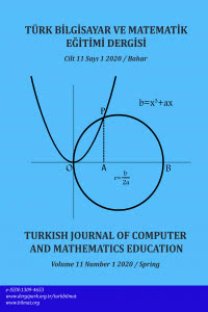The Ability of Pre-Service Primary Teachers to Produce Figural Patterns Based on Algebraic Formulas
The Ability of Pre-Service Primary Teachers to Produce Figural Patterns Based on Algebraic Formulas
In this study, the participants were asked to create figural patterns (figural representations) of two sequences, where the presentation is in the form of an algebraic formula. Those algebraic formulas were representing linear and quadratic (non-linear) patterns, in which pre-service primary teachers were asked to generate figural patterns based on those algebraic formulas. In total, 127 pre -service primary teachers participated in the study. The obtained data were analysed at two levels including both semantic and descriptive analyzes . The results of the study indicated that of 127 participants, 88 could generate a correct figural pattern of some kind for the given arithmetic sequence expressed via a linear function of n, while 72 were able to do so for the given non linear sequence expressed via a quadratic function of n. Follow-up individual interviews were conducted with 9 volunteer participants, reflecting a cross -section of types of responses, including some who were unable to respond and had some issues.
___
- Anthony, G., & Hunter, J. (2008). Developing algebraic generalisation strategies. In O.
- Figueras, J. L. Cortina, S. Alatorre, T. Rojano & A. Sepulveda (Eds.), Proceedings of the Joint Meeting of PME 32 and PME-NA XXX. Cinvestav, Mexico (Vol. 2, pp. 65 - 72). Mexico: Cinvestav UMSNH.
- Bassarear, T. (2008). Mathematics for elementary school teachers. (5th ed.). CA: Brooks/Cole.
- Bennett, A. B., & Nelson, T. L. (1998). Mathematics for elementary teachers: An activity approach. (4th ed.). Boston, MA: Mc Graw Hill.
- Blitzer, R. (2011). Thinking mathematically. (5th ed.). London, England: Pearson Education Limited.
- Brenner, M. E., Mayer, R. E., Moseley, B., Brar, T., Durán, R. , S., Reed, B., & Webb, D.
- (1997). Learning by understanding: The role of multiple representations in learning algebra. American Educational Research Journal, 34(4), 663-689.
- Cathcart, W. G., Pothier, Y. M., Vance, J. H., & Bezuk, N. S. (2003). Learning mathematics in elementary and middle schools. (3rd ed.). Englewood Cliffs, N.J.: Merrill/Prentice Hall.
- Chua, L. B., & Hoyles, C. (2010). Generalisation and perceptual agility: how did teachers fare in a quadratic generalising problem? Research in Mathematics Education, 12(1), 71-72.
- Fraenkel, J., R., & Wallen, N. E. (2005). How to design and evaluate research in education. (6th ed.). New York, NY: Mc Graw Hill.
- Fox, J. (2005). Child-initiated mathematical patterning in the pre-compulsory years. In H.
- L. Chick & J. L. Vincent (Eds.), Proceedings of the 29th Conference of the International Group for the Psychology of Mathematics Education. (Vol. 2, pp. 313- 320). Melbourne, Australia: University of Melbourne.
- Frobisher, L., & Threlfall, J. (1999). Teaching and assessing patterns in number in the primary years. In A. Orton (Ed.), Pattern in the teaching and learning of mathematics (pp. 84-103). London, England: Cassell.
- Gay, L. R., Mills, G. E., & Airasian, P. (2006). Educational research: Competencies for analysis and applications (8th ed.). Upper Saddle River, NJ: Pearson Prentice Hall.
- Hallagan, J. E., Rule, A. C., & Carlson, L. F. (2009). Elementary school pre-service teachers' understandings of algebraic generalizations. The Montana Mathematics Enthusiast, 6(1&2), 201- 206.
- Houssart, J. (2000). Perceptions of mathematical pattern amongst primary teachers. Educational Studies, 26 (4), 489-502.
- Hunting, R. P. (1997). Clinical interview methods in mathematics education research and practice. Journal of Mathematical Behavior, 16(2), 145-165.
- Increasing patterns (2009, February 15). Retrieved from http://www.learnalberta.ca/content/mepg2/html/pg2_increasingpatterns/index.html Janvier, B. D., & Bednarz, N. (1987). Pedagogical considerations concerning the problem of representation. In C. Janvier (Ed), Problems of representation in the teaching and learning of mathematics (pp. 67-72). New Jersey, NJ: Lawrence Erlbaum Associates.
- Lawrence A., & Hennessy, C. (2002). Lessons for algebraic thinking: Grades 6-8. CA: Math Solutions Publications.
- Lesh, R., Post, T., & Behr, M. (1987). Representations and translations among representations in mathematics learning and problem solving. In C. Janvier (Ed.), Problems of representation in the teaching and learning of mathematics (pp. 33-40). Hillsdale, NJ: Lawrence Erlbaum Associates.
- Lincoln, Y. S., & Guba, E. G. (1985). Naturalistic inquiry. Newbury Park, CA: Sage Publication.
- Lin, F-L., Yang, K-L., & Chen, C-Y. (2004). The features and relationships of reasoning, proving and understanding proof in number patterns. International Journal of Science and Mathematics Education, 2, 227-256.
- Merriam, S. B. (1998). Qualitative research and case study applications in education. (1st ed.). San Francisco, SF: Jossey-Bass.
- Başlangıç: 2009
- Yayıncı: Türkbilmat Eğitim Hizmetleri
Sayıdaki Diğer Makaleler
The Ability of Pre-Service Primary Teachers to Produce Figural Patterns Based on Algebraic Formulas
Mühendislik Öğrencilerinin E-Öğrenmeye Dair Hazır Bulunuşluk ve Memnuniyet Düzeyleri
Sekizinci Sınıf Öğrencilerinin Problem Kurma Becerilerinin Bazı Değişkenler Açısından İncelenmesi
Kemal ÖZGEN, Mehmet AYDIN, Mehmet Ertürk GEÇİCİ, Baran BAYRAM
